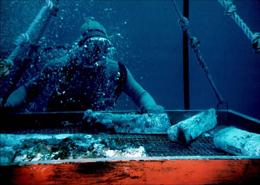Roman ingots to shield particle detector
- On 16/04/2010
- In Marine Sciences
- 0 comments

By Nicola Nosengo - Nature News
Around four tonnes of ancient Roman lead was yesterday transferred from a museum on the Italian island of Sardinia to the country's national particle physics laboratory at Gran Sasso on the mainland.
Once destined to become water pipes, coins or ammunition for Roman soldiers' slingshots, the metal will instead form part of a cutting-edge experiment to nail down the mass of neutrinos.
The 120 lead ingots, each weighing about 33 kilograms, come from a larger load recovered 20 years ago from a Roman shipwreck, the remains of a vessel that sank between 80 B.C. and 50 B.C. off the coast of Sardinia.
As a testimony to the extent of ancient Rome's manufacturing and trading capacities, the ingots are of great value to archaeologists, who have been preserving and studying them at the National Archaeological Museum in Cagliari, southern Sardinia.
What makes the ingots equally valuable to physicists is the fact that over the past 2,000 years their lead has almost completely lost its natural radioactivity. It is therefore the perfect material with which to shield the CUORE (Cryogenic Underground Observatory for Rare Events) detector, which Italy's National Institute of Nuclear Physics (INFN) is building at the Gran Sasso laboratory.
CUORE, which will begin operations next year, will investigate neutrinos: fundamental particles with no electronic charge and long thought to have no mass. Researchers have confirmed that neutrinos do have a mass, but have been unable to pin down a figure for it.
The aim is to use the detector to try to observe a theoretical atomic event called neutrinoless double-beta decay — a radioactive process whereby an atomic nucleus releases two electrons and no neutrinos. 'Standard' double-beta decay is accompanied by the release of two neutrinos.
By observing this predicted but so far unseen event, physicists hope to estimate the neutrino's mass and to establish whether neutrinos and their antimatter counterparts, antineutrinos, are different particles. Some believe the two to be one and the same.
CUORE scientists will wait for neutrinoless double-beta decay to happen in a 750-kilogram cube of tellurium dioxide placed under 1,400 metres of rock at the Gran Sasso laboratory.
But to successfully observe this rare event, they will need to shield their experiment from external radioactivity.
archaeology Sardinia ancient civilisation
Add a comment